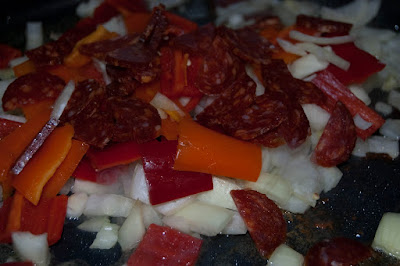Paella (pie-Ay-ya) is an old Spanish dish that my fiance and I were lucky enough to try while in Barcelona. This picture is from our trip when we tried some squid ink paella.
I've never actually made regular paella let alone paleo paella, but it seemed like it could be done. It was either going to turn out to be a complete failure or a success, and I'm happy to tell you that it wasn't an epic paleo-fail. This recipe takes a little under an hour, so it's not fast, but it can be done on a weeknight.
Here is what you need:
Starting at the mussels at the bottom: 1 lb of mussels (4.99), 1 orange ancient pepper(0.25), 1 red ancient pepper(0.25), 4 cloves of garlic (0.08), one can of diced tomatoes (1.59), cauliflower (2.34), parsley (0.05), 1 yellow onion (1.00), 1 lemon (0.25), paprika, 2-3 lbs of chicken thighs (3.24), 8 large shrimp (4.99), and (not pictured) a hot sausage (2.16)- we used a hot Italian sausage (salamini) our deli guy recommended. That's a total of 21.19, or roughly 4-5 dollars per serving. This is one of the pricier meals I've made, but it is worth it, I promise.
I prepped all the veggies and meat before starting to cook. It makes life a lot easier and I don't feel as rushed as I cook. You'll need to grate the cauliflower, grate the garlic as well as chop the onions, pepper, and sausage. This is also a good time to clean off the mussels. Just put them in a strainer and run your fingers over the shells, removing anything you can. If any of the mussels are open and don't close if you tap them on the counter, throw them away. They're dead.
Use the larger holes on your grater.
Cut the sausage into half circles.
Once all the chopping and cleaning is done, start by frying the chicken thighs in some olive oil. Make sure the oil is nice and hot so that you get a good sear on the chicken.
When the chicken has a good sear on each side (about 6 minutes on the first side and only about 4 on the second), set the chicken aside. Use the oil and chicken fat to fry up the onions, sausage, and peppers.
When the veggies are golden brown add the garlic. Make sure to keep stirring when the garlic is in the pan. You don't want the garlic to sit around a have a chance to burn. Garlic gets really bitter when it burns.
Stir for about 2 minutes, then you'll add the chicken back in along with the tomatoes and a handful of paprika.
Stir in the paprika and bring that up to a boil. Once it starts to bubble, add a lid and put bring heat down to about half. As that simmers, start heating up some olive oil in another pan. When that is hot, add the grated cauliflower. It will take a while for the cauliflower to turn brown which is fine because the paella needs to simmer for a while. Keep stirring and just don't let the cauliflower burn. Eventually it will turn brown.
When it is brown, add 100 ml of chicken stock and wait for it to evaporate. When it does, your cauliflower is done. Just set it aside.
It should take about 20 minutes for the cauliflower to be ready, so it's the perfect timing to get back to the paella. It can't really simmer too long with the lid on, so don't get stressed if it's taking your cauliflower longer to cook or if you have to do it in batches.
Now is the time to add the mussels. This is the perfect time to double check for dead guys. They'll be the ones that are open and won't close when you tap them on the counter. Throw them away.
Add the mussels to the mix and put the lid back on. The mussels will open up in about 2 minutes. At this point, add the shrimp and wait another 2 minutes.
Remove the lid and that's it! You've just made paella. Don't you feel classy? Not yet? Ok, add some parsley and lemon then, Mr. Belivedere. Now you're first class all the way.






















































